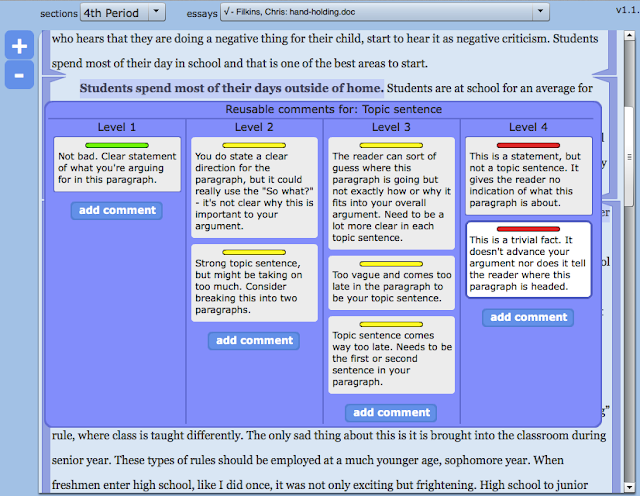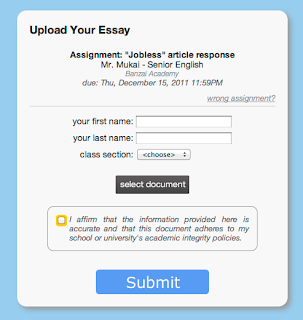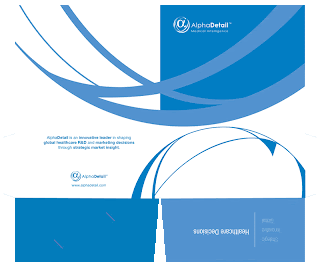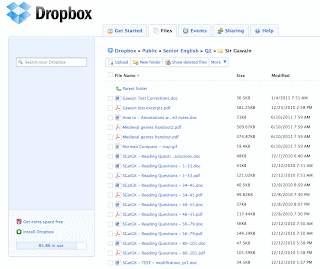As of today I have resigned from my teaching and coaching positions. Building EssayTagger.com will be my sole focus for the foreseeable future.
I agonized over this decision for months, but it essentially boiled down to the push and pull of two factors.
The first was that it was becoming clear that I could not function to the best of my ability in my current environment. I loved everything that was going on inside of my classroom, but--as most teachers are well aware--the frustrations outside of the classroom can become toxic and unbearable. I was working way too hard to be that unhappy.
But I don't want to dwell on past frustrations. This space is about looking ahead, working toward an exciting future.
And that's where the second part comes in.
 |
| A friend's photo, but a familiar sight. Poor Jess! |
My mentor told me that grading essays was by far the worst part of being a high school English teacher. I'm sure you teachers out there know well where he's coming from. I certainly felt that pain when I had 102 Senior English Lit synthesis papers come in on the same day.
While crawling through those papers I began to dream of ways to make grading more efficient. And then a killer idea crystalized.
As the days and weeks and months went by it became more and more clear that I needed to pursue this idea. It
IS the future of grading essays.
As a result, I'm pushing forward with an incredible amount of excitement that far outweighs the frustrations of the past.
I hope those of you who are teachers will forgive me for stepping off the front lines. But I believe in this product that we're building and I am confident that it will improve teachers' lives (how exactly will EssayTagger.com help you grade essays more efficiently? Well, we're still in stealth mode so you'll have to wait a few more weeks to find out).
So while I may no longer be directly impacting students, I am hoping to directly impact teachers (and, let's be honest, make a modest profit along the way!).
I also knew all along that this company would require my full attention; there was no way that I could build it in my free time and still teach and coach. I mean, "free time"?! What free time?! This was always going to be a full-time commitment.
The future looks bright
I am, by nature, a very risk-averse person. I hate gambling. I generally focus more on avoiding the worst-case scenario than shooting for the best-case scenario. It's not very exciting or sexy, but I play it safe.
And yet I have resigned from my job and am launching this startup company with zero fear. I am not up late at night, biting my fingernails, wondering if I'll default on my mortgage. Maybe I should be. Maybe I'm a fool.
 |
| 18"?! Just give up! |
But I know the pain that teachers feel when grading papers and I know that this product we're building can be a huge help. I know that the technology hurdles are daunting--especially since I'm about five years out of date on the latest programming tools and trends!--but I'm confident that I can overcome them. And, as you'll see in the coming weeks, I have access to some incredibly gifted and resourceful people that will be involved in the business.
I'm too optimistic and too excited about all of this to be nervous or scared. The opportunity here and the possibilities are so great that they've overridden my conservative, risk-averse nature.
I know that our profession needs as many dedicated, talented people it can find. I'd like to think I was one of the ones that fit that bill. And I am sorry to leave the ranks. But if I--if
we--can make this project a reality... well then we'll all have reason to celebrate.
The plan
Obviously we are already a few weeks into this project. Luckily I've got
my brother-in-law on board to help with the business side and I've been reaching out to people I know who can help out on the technology side.
We are tentatively planning a modest round of financing in mid-August to cover operating expenses for the first seven months. That's also the target for a working demo or site beta so we can show the investors what it is they're investing in.
Early September is the target for the actual site launch. We would likely begin with an open beta period for a month or so as we polish off the rough edges and continue implementing more features.
By October we should be fully up-and-running, focusing hard on spreading the word and attracting new users.
We've already figured out how to run the company for a ridiculously tiny amount of money. mostly thanks to crazy advances in technology and the fact that we'll only have one full-time employee: me! A small additional financing round will probably be necessary in March to bridge us to the point where we're making a profit.
I would like to give this company at least a year to see where we end up by September 2012. Because of the low costs of the operation, we don't need insane adoption rates to reach the break-even point. Our initial goal is to hit 1,000 paid users within the first 12-18 months; by Web terms that's just a drop of water in the ocean. There are about 125,000 high school English teachers in America, 114,000 Social Studies teachers, and untold tens of thousands of university instructors and professors that might benefit from our product. And we're just looking to nab 1,000 of them, initially.
I like our odds.
One final pic: At the peak of her insanity, Jess posted this photo with this caption:
 |
| "I r helpin u grade, cuz my grammer iz better than theirs." |
And no, cats trained to grade essays is not the solution I have in mind. Though I think maybe Flynn here should be our mascot!







































